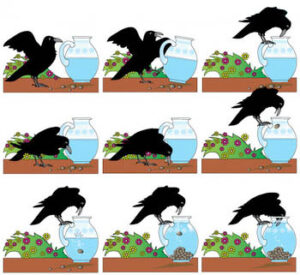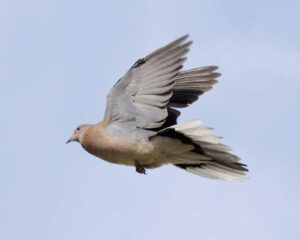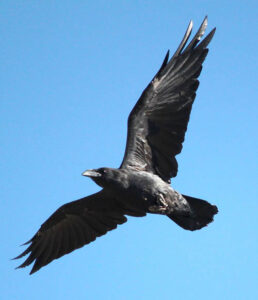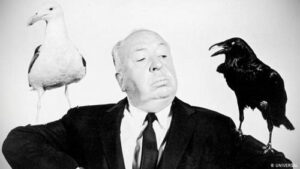Our Deep Connection to Birds
We all know songs that mention birds, from “Bye Bye Blackbird”, first published in 1924 by Jerome H. Remick, to the Beatles “Blackbird” from their 1968 White Album. Birds in song often symbolize something human, something we relate to that is often uplifting, even bordering on the spiritual. From ancient times to the pulsating present, birds are deeply ingrained in human culture.
 We look to birds as symbols of freedom, or the opposite when the bird is caged, or cunning in the “Crow and the Pitcher,” an Aesop fable where the crow figures out how to get a drink of water from a half-filled pitcher by dropping in pebbles until the water level is high enough for it to drink. They can represent rebirth like the mythical Phoenix that rises from the ashes. Or birds may represent omens of death as in the superstition that if you see 5 crows, sickness will follow; see 6 crows and death will come.
We look to birds as symbols of freedom, or the opposite when the bird is caged, or cunning in the “Crow and the Pitcher,” an Aesop fable where the crow figures out how to get a drink of water from a half-filled pitcher by dropping in pebbles until the water level is high enough for it to drink. They can represent rebirth like the mythical Phoenix that rises from the ashes. Or birds may represent omens of death as in the superstition that if you see 5 crows, sickness will follow; see 6 crows and death will come.
 Birds figure prominently in human mythology, as part of our collective consciousness. Myths such as that of the Roc, an enormous legendary bird of prey, appears in the popular mythology of the Middle East. The Roc even appears in Arabic geographies and natural history. The ancient Egyptians had a creation story featuring a long-legged wading heron. It tells of the time when land rose out of the primeval waters of chaos; the first deity to appear was a bird perching on that land. In the myths of various Native American peoples, the eagle is a cultural hero with stories of eagles fighting snakes or dragons, representing the tension between light and darkness, heavenly and underworld forces. Myths involving birds come from every part of the earth and show how integral birds are to human civilization.
Birds figure prominently in human mythology, as part of our collective consciousness. Myths such as that of the Roc, an enormous legendary bird of prey, appears in the popular mythology of the Middle East. The Roc even appears in Arabic geographies and natural history. The ancient Egyptians had a creation story featuring a long-legged wading heron. It tells of the time when land rose out of the primeval waters of chaos; the first deity to appear was a bird perching on that land. In the myths of various Native American peoples, the eagle is a cultural hero with stories of eagles fighting snakes or dragons, representing the tension between light and darkness, heavenly and underworld forces. Myths involving birds come from every part of the earth and show how integral birds are to human civilization.

 In the Bible, birds or fowl are mentioned 182 times in the Old Testament and 29 times in the New Testament. The first bird mentioned by name in the Bible is the Raven (Gen. 8:7). Noah sent it forth till the flood waters dried up. Then Noah sent out a Dove (Gen. 8:8, 11-12)
In the Bible, birds or fowl are mentioned 182 times in the Old Testament and 29 times in the New Testament. The first bird mentioned by name in the Bible is the Raven (Gen. 8:7). Noah sent it forth till the flood waters dried up. Then Noah sent out a Dove (Gen. 8:8, 11-12)
We are so connected to birds that we have made many of them avatars of human characteristics or adopted their characteristics into our everyday language: Straight as the crow flies, a bird in a gilded cage, the early bird catches the worm, birds of a feather flock together, a bird’s eye view, the wise owl, or the dove of peace.
We are thrilled by their flight and dazzling array of forms and colorations, but it is the music of birds, their song that elevates us the most. It is why Rachel Carson was bereft at the growing loss of bird song as she wrote Silent Spring.
It explains, perhaps, why birds are an omnipresent theme in so much of popular music to this day. There are so many songs that mention birds it would be impossible to list them all. But here are just a few. You can sing or hum along, even take a moment to think of others you know that mention a bird…
Rockin’ Robin – Bobby Day (Original by Leon René, 1958)
He rocks in the tree tops all day long
Hoppin’ and a-boppin’ and singing his song
All the little birdies on Jaybird Street
Love to hear the robin go tweet tweet tweet
When Doves Cry – Prince (1984)
Maybe I’m just like my father, too bold
Maybe you’re just like my mother
She’s never satisfied (she’s never satisfied)
Why do we scream at each other?
This is what it sounds like
When doves cry
Bird on a Wire – Leonard Cohen (1968)
Like a bird on the wire
Like a drunk in a midnight choir
I have tried in my way to be free
El Condor Pasa – Simon & Garfunkel (Adapted from Daniel Alomía Robles’ original, 1913)
I’d rather be a sparrow than a snail
Yes, I would
If I could
I surely would
The Raven – The Alan Parsons Project (inspired by the poem by Edgar Allen Poe)
To my amazement
There stood a raven
Whose shadow hung above my door
Bluebird – Robin Trower (His first name is a bird!)
Growing quieter as you watch the snow: fallin’ down down
Down down
If you want to know his heart,
Listen.
Listen to the bluebird sing.
Seagull – Bad Company (1974)
Seagull, you fly across the horizon
Into the misty morning sun
Nobody asks you where you are going,
Nobody knows where you’re from
Canary in a Coalmine – The Police (1980)
First to fall over when the atmosphere is less than perfect
Your sensibilities are shaken by the slightest defect
You live you life like a canary in a coalmine
Mockingbird – Carly Simon & James Taylor (1974, Originally recorded by Inez and Charlie Foxx, 1963)
Everybody have you heard
He’s gonna buy me a mockingbird
And if that mockingbird won’t sing
He’s gonna buy me a diamond ring
We owe much of our foundational mythology, music, even art, to birds.

 Many famous paintings feature birds including, just to name a few, Vincent Van Gogh’s “Wheatfield with Crows” (1890), “The Magpie” by Claude Monet (1868) and “The Goldfinch” (1654) by Carel Fabritius from the Dutch golden Age.
Many famous paintings feature birds including, just to name a few, Vincent Van Gogh’s “Wheatfield with Crows” (1890), “The Magpie” by Claude Monet (1868) and “The Goldfinch” (1654) by Carel Fabritius from the Dutch golden Age.
Many of the films that left a lasting mark on our culture also feature birds. When Alfred Hitchcock released his movie “The Birds” in 1963 it became such an important touchstone that it was deemed “culturally, historically, or aesthetically significant” by the United States Library of Congress, and selected for preservation in its National Film Registry. Some of our most stunning documentaries are based on birds and their struggles and triumphs such as “March of the Penguins,” “Winged Migration,” and “The Messenger.”
We all have so much in common with birds that we often take them for granted. They have always been with us and always will be. But maybe not…
Songbirds alone in North America are vanishing at a frightening rate. According to Science magazine, three billion North American birds have vanished since 1970. This represents nearly 30% of the total. Even common birds such as sparrows and blackbirds are in serious decline. This alarming statistic raises the specter that many familiar species will go the way of the Passenger Pigeon, declared extinct on September 1, 1914, when the last known passenger pigeon, a female named Martha, died at the Cincinnati Zoo
Birds have given us so much, it’s time we gave back to them.
Click here for 10 ways to help birds from the Cornell School of Ornithology. The list is everyday things you can do to help our feathered friends. So, the next time you see the beauty of a bird or delight in its song, say thanks.
 Ross Feldner is the lead, with Bob Musil, of the RCC Bird Watch and Wonder Program. Ross is a life-long birder and photographer who is the editor of the Friends of Patuxent National Wildlife Refuge newsletter. Ross also serves as a guide at the Patuxent National Wildlife Refuge, a frequent birding spot for Rachel Carson who first learned about the health effects of DDT at the laboratory there. He is also the owner/art director of New Age Graphics, a full-service graphic design firm in Wheaton, MD.
Ross Feldner is the lead, with Bob Musil, of the RCC Bird Watch and Wonder Program. Ross is a life-long birder and photographer who is the editor of the Friends of Patuxent National Wildlife Refuge newsletter. Ross also serves as a guide at the Patuxent National Wildlife Refuge, a frequent birding spot for Rachel Carson who first learned about the health effects of DDT at the laboratory there. He is also the owner/art director of New Age Graphics, a full-service graphic design firm in Wheaton, MD.






